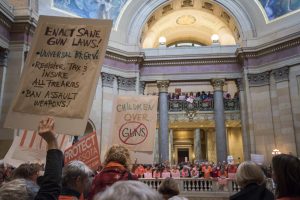Ed Day
Share:
When most students think of political activism, they think of massive demonstrations with people wearing pink or red hats holding up signs while listening to riveting speeches and slogans shouted through a bullhorn.
But activism can take many other forms.
Attending your precinct caucus Tuesday, Feb. 6, to sit in a local classroom listening to party leaders discuss protocols and resolutions sounds a lot more boring (because it is), but it is still an important form of activism. Long before the election season reaches a fever pitch this fall—with the wall-to-wall political advertising, endless robo-calls and mass emails telling you why their opponent is a loser—this very unspectacular process is how each political party begins selecting who will represent them on the November ballot.
The 2018 elections are especially important in Minnesota because the ballot will feature several statewide races: governor, attorney general, state auditor, secretary of state, and two U.S. Senate seats. Both longtime incumbent Sen. Amy Klobuchar, and Sen. Tina Smith, who recently replaced Al Franken, are up for reelection. There are already 11 Democratic and Republican declared candidates running for governor. Have a favorite? Attend your precinct caucus to show your support.
Here’s why you should get to your caucus:
Amplify your voice
Fewer people attend precinct caucuses than vote. This means a small number of people in each party have an outsized influence in which candidates are endorsed. (Yes, this is a big reason Minnesota will switch to a primary election in 2020, but it is still a great reason to attend this year).
Introduce your ideas
Do you care about education funding? Gun policy? Taxes? The minimum wage? Healthcare initiatives or lack thereof? If you have any issue you’d like to see changed, you can write a resolution at the precinct level and see how it stacks up. Even if your idea does not get adopted in the party’s statewide platform, it’s a good exercise as it forces you to succinctly sum up your argument.
Several years ago, I introduced a resolution for the city of St. Paul calling for private universities to start paying property taxes. My precinct adopted it, but it didn’t make it much further. Today, a version of it is being considered by City Hall. (Yes, political change does not always happen overnight).
Represent your neighbors
Every precinct elects delegates to represent your neighborhood at the next level. Depending on how the party is structured, the hierarchy is precinct, state senate district, congressional district, and statewide. Statewide conventions take place June 1 to 3 for Democrats and June 1 and 2 for Republicans. These are pretty big events, so it’s fun to be a delegate to a state convention.
Meet your neighbors
Obviously, you’ll meet your neighbors before you represent them. When you arrive, take a good look around: these are the local political activists. Caucuses are a good place to learn about issues that might not otherwise be on your radar. (Everyone has their own axe to grind!)
But also think about the people who aren’t there. Who do you know that would like to get involved, but could not take time off from work? Can you think of anyone who cannot speak for themselves?
Step outside your comfort zone
In St. Paul, precinct caucus attendance is almost a ritual for longtime residents, so jumping in can seem a little daunting. But if you made it this far, try signing up for a committee or a job no one else wants to do.
I signed up for the resolutions committee, which involved discussing with four other people dozens of similar ideas and consolidating them into an acceptable format (read: the shortest possible list) for delegates to vote on. Reviewing the array of issues people brought forward was an eye-opening experience.
Finally, by attending the caucuses you’ll achieve immortality! Not really, but there is a chance you’ll be one of the last people to attend a precinct caucus in Minnesota. You’ll have some extra political “street cred” years from now when you describe how it was back in the day.
Precinct caucuses are Tuesday, Feb. 6. Have a class that night? No excuse. Per state law, Metro State (and all Minnesota state colleges and universities) can not hold evening classes and events after 6 p.m.
Find the location of your precinct caucus here:
Contact your party leadership with questions (includes minor parties):
sos.state.mn.us/elections-voting/how-elections-work/political-parties
General information about caucuses:
sos.state.mn.us/elections-voting/how-elections-work/precinct-caucuses


